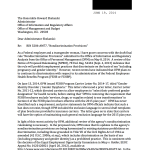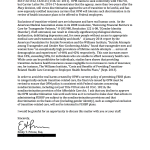Since OIRA decided not to meet with me today, I had time to do another small letter; this one to OPM, demanding the records establishing their purported “policy” of required exclusions for transition-related care. Given that we know that the purported policy was ignored for some insurers (see, for instance, Kaiser Foundation’s California health insurance plan, available at http://www.opm.gov/healthcare-insurance/healthcare/plan-information/plan-codes/2014/brochures/73-003.pdf), I’m intensely curious where this alleged requirement existed (and how it was waived for Kaiser).
Monthly Archives: June 2014
OIRA: Meeting Request regarding OPM Nondiscrimination Rule
Fired off another letter today, this one to OIRA to get some visibility on the OPM actions to explicitly approve discriminatory health insurance plans for Federal employees.
Some Notes on OPM “Lifting a Ban” on Transition-Related Care
UPDATE: On August 25, 2014 OPM responded to my FOIA request and formally acknowledged that no “requirement to exclude” transition-related care existed.
Yesterday the Office of Personnel Management (OPM) – succinctly described as the head human resources department for the Federal government at large – issued a “carrier letter” (the Carrier Letter)[1] to health insurance providers participating in the Federal Employees Health Benefits Program (FEHBP). The letter indicated that OPM was lifting a requirement[2] that transition-related care (or, in their terms “services, drugs or supplies related to sex transformation”) be excluded from FEHBP plans, but stopped short of mandating that transition-related care affirmatively be included. Prominent LGBT organizations such as the Human Rights Campaign (HRC) and the National Center for Transgender Equality (NCTE) praised the move[3] as a step forward. I remain skeptical however, and posted a host of concerns about the action to Twitter; some of these concerns were republished in the Advocate.[4] However, because Twitter is not an ideal platform for legal analysis, and because as a lawyer I find it difficult to use one word where I could use ten, I am taking a moment to recompile my argument and concerns into a more coherent form.
One important thing to remember in the context of trans-inclusive healthcare is that there are a number of balls in the air right now, mostly being juggled by the Office of Information and Regulatory Affairs (OIRA) within the Office of Management and Budget (OMB). OIRA’s role in the rulemaking process focuses on ensuring consistency in regulations government-wide as well as reducing regulatory burdens. As implementation of the Affordable Care Act (ACA or “Obamacare”)[5] continues, there are a number of healthcare nondiscrimination rules in various stages of the rulemaking process. On May 27, after receiving clearance from OIRA,[6] the Department of Health and Human Services (HHS) published a final rule[7] which, among a great many other things, prohibited discrimination on the basis of gender identity as a variety of discrimination on the basis of sex, consistent with the Equal Employment Opportunity Commission’s (EEOC) ruling in Macy v. Holder.[8] However, neither the rule itself nor the preamble to the rule published in the Federal Register define what constitutes such discrimination, leaving a substantial question to be answered.
Meanwhile, as of May 8, 2014, OPM has had its own general nondiscrimination final rule under review by OIRA.[9] The proposed regulation, published on September 4, 2013,[10] prohibits employment practices discrimination on the basis of gender identity, again as a variety of discrimination on the basis of sex. The proposed rule did not specify what impact, if any, this would have on OPM review of FEHBP plans. The final rule is scheduled to be published this month, according to the Unified Agenda of Federal Regulatory and Deregulatory Actions, published May 23, 2014.[11]
Finally, and most importantly, HHS is currently drafting an interpretation or regulation implementing 42 USC 18116,[12] the provision of the ACA that bans discrimination on the basis of sex (and therefore also on the basis of gender identity). That document was, as of the May 23, 2014 publication of the Unified Agenda, slated for publication by August 2014. Because 42 USC 18116 reaches Medicare, Medicaid (as expanded in many states by the ACA), the exchanges, FEHBP, other government health insurance programs such as SCHIP, and possibly more, it is easy to see why the rule is important.[13] Unfortunately, the HHS decision-making process is opaque, and outside advocates are left only with small clues as to how the Administration may be leaning on transition-related care.[14] Until recently (at least as late as August 2013), HHS stated on its website that transition-related care was not required as a result of the nondiscrimination statute.[15] The Q&A within which that statement appeared has since been removed from the HHS website. Contemporaneous with the removal, HHS published a formal Request for Information in the Federal Register on August 1, 2013, seeking information on “experiences with discrimination in health programs or activities,” including discrimination on the basis of gender identity as a variety of discrimination on the basis of sex. The request for information, combined with the removal of the Q&A, gave cause for hope that HHS would prohibit exclusions for transition-related care as discriminatory, especially when combined with the May 30, 2014 ruling by an HHS administrative adjudicatory body that Medicare’s categorical ban on coverage for “transsexual surgery” was invalid.[16]
Given the context of one recently-published HHS regulation on nondiscrimination, one OPM regulation on nondiscrimination currently review at OIRA, and the critical HHS rule interpreting what “nondiscrimination” means in the context of health insurance and transgender patients, the important question is: what did we learn from the OPM carrier letter about how the Administration views the exclusion of transition-related care and nondiscrimination provisions? Here is where my disagreement with HRC and NCTE lies. Viewed in isolation, OPM making clear that transition-related care is medically necessary and explicitly authorizing plans to cover such care would be a small but unequivocally positive step towards trans-inclusive health insurance for all. However, when viewed as a policy decision made by agencies with internal preferences that are revealed through actions such as these, the decision to lift a purported ban[17] but nonetheless permitting trans-exclusive policies generates quite a bit of concern. That policy decision suggests that OPM, and possibly OIRA and HHS, may be ready to take the public position that plan language explicitly excluding coverage for “sex transformation” is somehow not discriminating on the basis of sex or gender identity. Other hypotheses have been raised to explain the decision, such as the idea that OPM does view the exclusion language to be discriminatory but is exercising enforcement discretion on behalf of insurers who feel incapable of removing the exclusion for plan year 2015. This sort of hypothesis is consistent with the evidence available, but raises new questions, such as why OPM would not admit that position directly.
It is possible that yesterday’s announcement was a step forward and that the HHS interpretation of the ACA’s nondiscrimination language will finally bring trans-inclusive health insurance to a large set of people who need the coverage. However, with the evidence we have, it seems far too early for celebration. Yes, the carrier letter issued yesterday suggests some number of trans Federal employees will have access to trans-inclusive health insurance, but that may have been a harbinger of coming disappointments in the fight for everyone to have access to affordable transition-related care. That war continues, and it’s important to be able to distinguish a tactical retreat by the opposition from an actual victory.
[1] John O’Brien, Director – Healthcare and Insurance, Office of Personnel Management, “Gender Identity Disorder / Gender Dysphoria,” Carrier Letter No. 2014-17, issued June 13, 2014. http://www.opm.gov/healthcare-insurance/healthcare/carriers/2014/2014-17.pdf
[2] Note that the Carrier Letter referenced in Note 1 does not specify what “requirement” it is lifting. No regulatory provision is cited, nor does OPM reference a prior carrier letter requiring such exclusions. A search of publicly-available records indicates no such requirement exists. While OPM did include such exclusions within plan brochure templates for use by insurance carriers, those brochures were informal guidance and not a statement of agency policy as to what benefits were or were not required in order to participate in FEHBP. Unless and until OPM produces records indicating that such a requirement actually existed, there is no basis to believe that the Carrier Letter actually lifted an OPM requirement that insurers exclude transition-related care.
[3] Chris Geidner, “Exclusive: Feds to Lift Ban on Federal Employee Insurance Coverage of Sex-Reassignment Surgery,” published June 13, 2014, available at http://www.buzzfeed.com/chrisgeidner/feds-to-lift-ban-on-federal-employee-insurance-coverage-of-s (“In a statement, Human Rights Campaign Government Affairs Director David Stacy said, ‘Today’s welcome decision by the Office of Personnel Management to remove this discriminatory and harmful exclusion is an important step towards closing the gap in access to quality health care for transgender workers. HRC urges FEHB insurance carriers to include this essential coverage in their plans so that federal workers have access to medically necessary transition-related care.’”); National Center for Transgender Equality, “Victory! Federal Government Modernizes Health Insurance,” published June 13, 2014, http://transgenderequality.wordpress.com/2014/06/13/victory-federal-government-modernizes-health-insurance/.
[4] Parker Marie Molloy, “Federal Employee Health Plans Can Now Include Transition-Related Health Care,” June 13, 2014, http://www.advocate.com/politics/transgender/2014/06/13/federal-employee-health-plans-can-now-include-transition-related.
[5] Public Law 111-148, “Patient Protection and Affordable Care Act” and Public Law 111-152, “Health Care and Education Reconciliation Act of 2010,” available at http://housedocs.house.gov/energycommerce/ppacacon.pdf.
[6] OIRA Regulatory Dashboard, http://www.reginfo.gov/public/do/eoDetails?rrid=124090.
[7] Department of Health and Human Services, “Patient Protection and Affordable Care Act; Exchange and Insurance Market Standards for 2015 and Beyond,” 79 Fed. Reg. 30239 (May 27, 2014), available at https://www.federalregister.gov/articles/2014/05/27/2014-11657/patient-protection-and-affordable-care-act-exchange-and-insurance-market-standards-for-2015-and.
[8] Macy v. Holder, EEOC Appeal No. 0120120821 (April 20, 2012), available at http://www.eeoc.gov/decisions/0120120821%20Macy%20v%20DOJ%20ATF.txt.
[9] OIRA Regulatory Dashboard, http://www.reginfo.gov/public/do/eoDetails?rrid=124099; http://www.reginfo.gov/public/do/eAgendaViewRule?pubId=201404&RIN=3206-AM77.
[10] Office of Personnel Management, “Nondiscrimination Provisions,” 78 Fed. Reg. 54434 (Sept. 4, 2013), available at https://www.federalregister.gov/articles/2013/09/04/2013-21486/nondiscrimination-provisions.
[11] OIRA Regulatory Dashboard, http://www.reginfo.gov/public/do/eAgendaViewRule?pubId=201404&RIN=3206-AM77.
[12] 42 USC §18116, “Nondiscrimination,” (also referred to as Pub. L. 111-148, Title I, §1557), available at http://www.gpo.gov/fdsys/pkg/USCODE-2010-title42/html/USCODE-2010-title42-chap157-subchapVI-sec18116.htm.
[13] See, for example, Department of Health and Human Services, “Section 1557 of the Patient Protection and Affordable Care Act,” available at http://www.hhs.gov/ocr/civilrights/understanding/section1557/.
[14] For an example of such attempts to interpret what little information we have, see for instance Andy Medici, “Is the Administration Moving to Include Transgender Care in Federal Health Insurance Coverage?” Dec. 9, 2013, http://blogs.federaltimes.com/federal-times-blog/2013/12/09/is-the-administration-moving-to-include-transgender-care-in-federal-health-insurance-coverage/.
[15] https://web.archive.org/web/20130802095418/http:/www.hhs.gov/ocr/civilrights/resources/laws/section1557_questions_answers.html.
[16] Department of Health and Human Services Departmental Appeals Board, Docket No. A-13-87, Decision No. 2576, May 30, 2014, available at http://www.hhs.gov/dab/decisions/dabdecisions/dab2576.pdf.
[17] See note 2, above, on why it should not be taken as given that such a ban existed.


